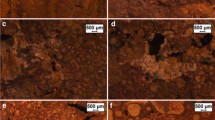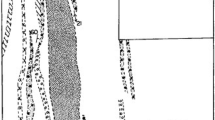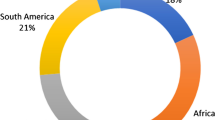Abstract
Three typical litho-types such as ‘saprolite,’ ‘bauxite’ and ‘laterite/lateritic ore’ from different levels of khondalite-hosted bauxite profile of Baphlimali plateau, Rayagada district, Odisha, Eastern India, have been studied. Mineralogical variations between different size fractions are interpreted for their optimum utilization. Mineralogy of individual bulk and its respective classified fractions are established from their XRD, DTA and TGA patterns. The saprolite, present in the lower most level of the profile, is rich in aluminum silicate (kaolinite), does not find use in alumina refinery and is usually considered as waste. However, if it is size-classified, the − 2.0 + 0.50 mm fraction, measuring over 21% by volume of the bulk, is found to contain substantial amount of gibbsite that can be separated and utilized for alumina recovery. The bauxite, present at the intermediate level of the profile, is rich in aluminum hydroxide (gibbsite). However, sometimes it contains hematite as major impurities (Fe ~ 10%). Though such ore is of metallurgical grade, around 26 vol% of the ore can be used for refractory purpose by simple separation of < 0.15 mm fraction. The ‘laterite,’ present in the upper most level of the profile, constitutes a mixture of gibbsite, kaolinite, hematite/goethite. Though its Fe-content is within permissible limit, the reactive silica contributed by kaolinite inhibits its use in alumina refinery. However, separation of − 2.0 + 0.25 mm size fraction from the bulk, amounting to 42% by volume, reduces kaolinite content appreciably. The study thus demonstrates that by simple size classification, different litho-types from a bauxite profile can be optimally utilized.









Similar content being viewed by others
References
India Mineral Yearbook, Government of India, Ministry of Mines, Indian Bureau of Mines, 54th Edition. India (2018).
Smith Peter, The processing of high silica bauxites-Review of existing and potential processes, Hydrometallurgy 98, (2009), Issue-1–2, p 162–176
Zhao Qun, Miller J.D, Wang Xuming, Recent developments in the beneficiation of Chinese Bauxite, Mineral processing and extractive metallurgy review, 31, (2010) Issue-2.
Yang YU Xin, Wang Hao lin, Wang Qiang-quing, Feng Bo, Zhong Hong, Flotation of low-grade bauxite using organosilicon cationic collector and starch depressant. Transitions of Nonferrous Metal Society of China. 26, (2016), Issue 4.
Fernanda A. N. G. Silva, Barbato, C. N., Almeida, D. S. G. João A. Sampaio, Marta E. Medeiros, Francisco M. S. Garrido, Reduction of Reactive Silica from Bauxite. Proceedings of 19th ICSOBA, Berlin 1 (2012), p 16–21.
Rao D.S, Das B, Characterization and beneficiation studies of a low-grade bauxite ore, J. Inst. Eng. India Ser. D (2014), p 81–93.
Ahmad Ishaq, Hartge Ernst Ulrich, Werther Joachim, Wischnewski Reiner Bauxite washing for the removal of clay, International Journal of Minerals, Metallurgy and materials 21 (2014), p 1045.
Mohapatra, B.K, Mineralogical and geochemical studies of the Iron Ore Group around ‘Barsua, Kalta, Koira’ region, Orissa, India, with special reference to associated ore deposits, Unpublished PhD thesis, Utkal University, India (1992).
Mohapatra, B.K., Rao, M.B.S., Rao, R.Bhima, Paul. A.K. Characteristics of red mud generated at NALCO refinery, Damanjodi, India. Light Metal. (Warrensdale, Pa), (2000) p 161–165
Sen, A.K., The weathering profile at Panchpatmali plateau, Koraput District, Orissa. Geological Survey of India 112, (1982) p 49–53
Bhukte, P.G; Chaddha, M.J. Geotechnical evaluation of Eastern Ghats bauxite deposits of India. Journ. Geol. Soc. Ind. 84, (2014), p 227–238
JCPDS data book Int. center of diffraction data, 1601, Pennsylvania, USA (1980).
Sengupta, P.R Thermogravimetric analysis of a few minerals and mineral assemblages of Indian occurrences. Indian Minerals, 37 (3), (1983), p 53–59.
Acknowledgements
The authors are thankful to Mr. D. P. Mishra, Senior Vice President, Utkal Alumina, Tikiri, for giving necessary permission for sampling and providing all logistic support during the field work.
Author information
Authors and Affiliations
Corresponding author
Additional information
Publisher's Note
Springer Nature remains neutral with regard to jurisdictional claims in published maps and institutional affiliations.
Rights and permissions
About this article
Cite this article
Sahoo, S., Mishra, P., Mishra, P.C. et al. Size Classification vs. Mineral Distribution and Its Implication in Optimum Utilization of Khondalite-Hosted Bauxite Ore from Eastern India. Trans Indian Inst Met 73, 2161–2172 (2020). https://doi.org/10.1007/s12666-020-02016-5
Received:
Accepted:
Published:
Issue Date:
DOI: https://doi.org/10.1007/s12666-020-02016-5




